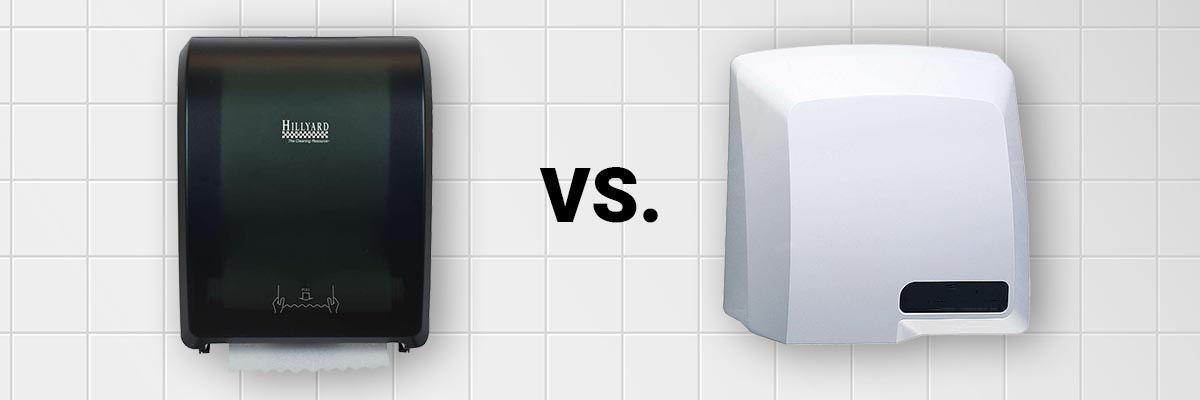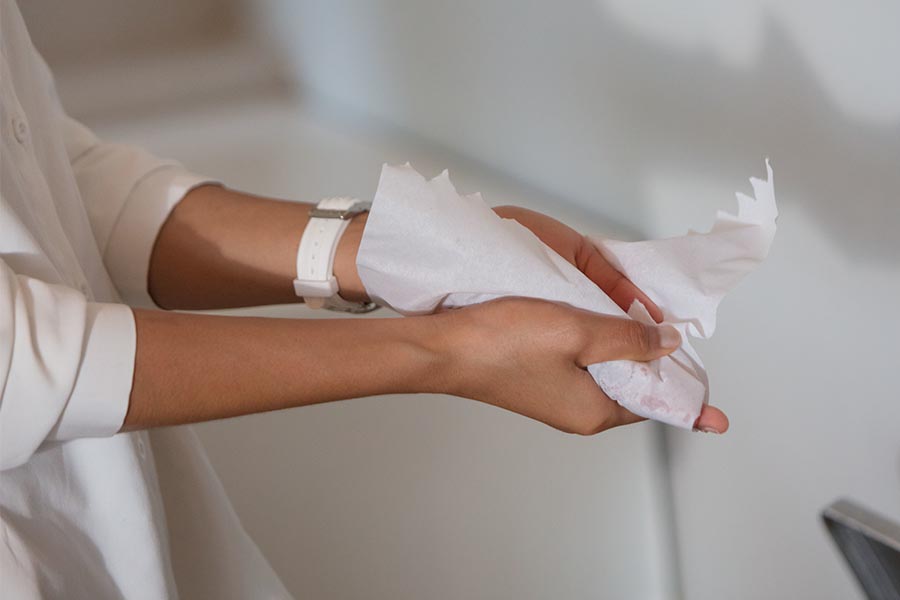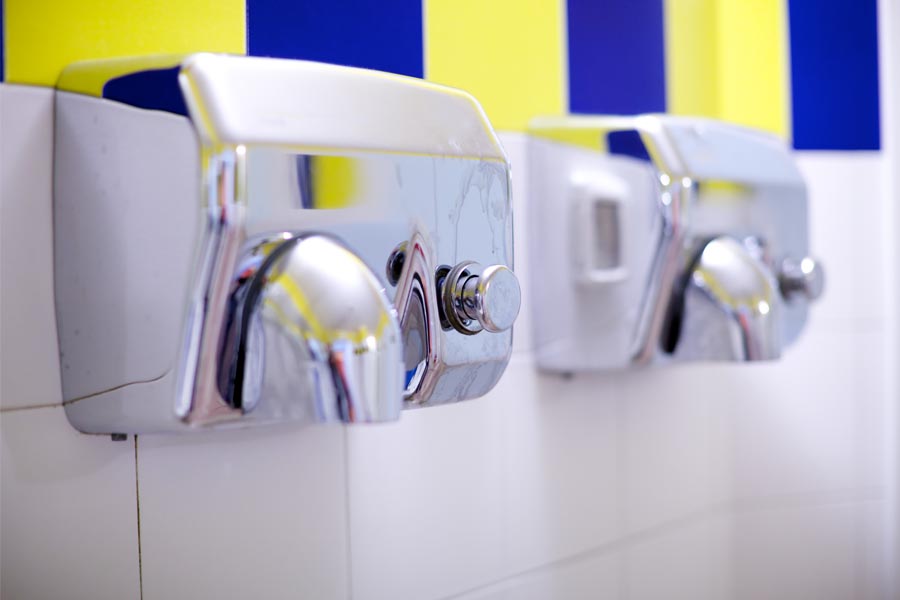Paper Towels vs. Hand Dryers: 2024 Update
Bacteria are more likely to be transferred from wet skin to dry skin, so effective drying after washing is essential to hand hygiene. Regarding hand-drying methods in public restrooms, there are two leading contenders: paper towels and hand dryers. Both options have advantages and disadvantages, and in this article, we will explore their different aspects to help you make an informed decision. We'll delve into topics such as the environmental impact, the spread of bacteria, the drying process, and more. Whether you are concerned about hygiene, sustainability, or efficiency, we will provide an overview, allowing you to weigh the pros and cons and decide which option is best for you.

Advantages & Disadvantages of Paper Towels

Paper towels have long been a popular choice for drying hands in public bathrooms, and for good reason. There are several advantages to using paper towels over hand dryers.
Paper towels are more hygienic. Sometimes people don't use proper technique when they wash their hands, and they arrive at the drying station with residual bacteria on their skin. A study published in the Mayo Clinic Proceedings shows that paper towels are more effective in removing pathogens from hands than hand dryers. This is because the friction created by rubbing the hands with a paper towel helps to physically remove bacteria and viruses, while hand dryers may actually spread them around due to their forceful airflow.
Furthermore, they provide convenience in busy public restrooms. They are quick and easy to use, allowing people to dry their hands efficiently and move on. This is especially important in high-traffic areas where there may be a constant stream of bathroom visitors. The Mayo Clinic study referenced earlier also showed that people prefer paper over hand dryers, partly due to this convenience.
Another key advantage of towels is the lack of cross-contamination they provide. With hand dryers, there is always a risk of residual bacteria being blown onto hands that are not completely dry. In contrast, paper is single-use and can be easily disposed of, minimizing the potential spread of bacteria and removing bacteria from the bathroom through trash disposal.
Because paper towel dispensers are either fully mechanical or use batteries, they are easier to install and can be quickly added to locations where hand drying needs improvement. Of course, if you choose a battery powered dispenser, be sure to stock your supply closet with the appropriate battery. Moreover, dispensers can be installed with general labor rather than a skilled electrician, making them a simple way to improve hand drying in your restrooms.
Many manufacturers offer recycled paper products to minimize the environmental impact of paper towels. Hillyard's Green Select Choice towels are Green Seal certified, contain 100% recycled materials and a minimum of 50% post-consumer waste.
2024 Update: Hillyard has launched a new line of Universal Paper Dispensers, designed for commercial settings, offering high-quality, competitively priced dispensers with multiple paper options and styles, including new white dispensers. The line includes various models such as jumbo toilet paper dispensers, multi-fold paper towel dispensers, double roll toilet paper holders, and auto-cut mechanical paper towel dispensers, all made from durable ABS plastic. These dispensers aim to provide facility managers with versatile and cost-effective solutions for their hygiene needs. For more information, see this article: Hillyard Launces a New Line of Universal Paper Dispensers.
Advantages & Disadvantages of Hand Dryers

Warm air and jet air dryers have advantages and disadvantages compared to towels. One of the main advantages is convenience. They eliminate the need to restock towels and reduce solid waste. While saving on paper may be a nice benefit, they have little impact on the total service requirements of the restroom. Custodians must regularly clean toilets, fixtures, empty trash, and floors to maintain a hygienic environment. Therefore, the impact on total cleaning labor is minimal.
However, it is important to acknowledge the potential issues with hand dryers. One primary concern is hygiene. A study in the Journal of Hospital Infection showed they could blow bacteria and viruses into the air, increasing the risk of cross-contamination. Another study showed that jet hand dryers, which use high-velocity cold air, spread germs further than their hot counterparts. This is especially concerning in healthcare and clinical settings where maintaining a sterile environment is crucial.
Additionally, air hand dryers may not effectively dry hands, leaving them damp and more susceptible to bacterial growth and cross-contamination. This can contribute to an unhygienic washroom environment.
Finally, air hand dryers are a slow way to dry hands compared to paper towels. In busy environments, people can be frustrated by the lines around air dryers and may opt to either not wash their hands or dry their wet hands on their clothes. Whichever the case, the net result is a reduction in hygiene.
In summary, while hand dryers offer convenience and cost-effectiveness, their potential drawbacks include hygiene concerns, cross-contamination, and possible bacterial growth. It is essential for businesses to weigh the advantages and disadvantages before deciding on the hand-drying method that best suits their needs.
Conclusion
In conclusion, there are advantages and disadvantages to both paper towels and hand dryers. Paper towels provide better hygiene and convenience but produce more solid waste. Hand dryers offer cost-savings and reduce paper waste, but they are slower to dry and carry the risk of spreading bacteria and viruses.
When it comes to choosing between paper towels and hand dryers for your restroom, there are a lot of factors to consider. You need to think about cost and effectiveness and how each option fits in with your restroom's overall look and feel. Fortunately, Hillyard representatives can help you weigh the pros and cons of each option to ensure that you make the best decision for your facility. Use the "I'm Interested" form at the bottom of this page, and one of our representatives will contact you.
Frequently Asked Questions
Are hand dryers better than paper towels?
Hand dryers have a few advantages over paper towels, but some studies show they are less hygienic. Sometimes people who wash their hands sometimes do an incomplete job. Microbes left on their hands transfer to surfaces in the bathroom. Hand dryers may cause some of those microbes to become airborne. Advantages include a reduction in solid waste in the bathroom and a lower operating cost. Paper towels help remove microbes from peoples hands and they are faster to use.
Are paper towels cheaper than hand dryers?
Hand dryers will cost more to purchase, but have a lower operating cost. Paper towels, while more expensive to operate, are believed to do a better job in reducing the spread of germs in public bathrooms.
Is drying hands with paper towels more hygienic than using warm air dryers?
Sometimes people who wash their hands sometimes do an inadequate job. Germs left on their hands transfer to surfaces in the bathroom. Some studies have shown that hand dryers may cause some of those microbes to become airborne. On the other hand, paper towels can remove microbes from your hands without the risk of creating airborne germs. The microbes removed from your hands end up in the trash can with the towel and are eventually removed from the restroom.
Should you use paper towels to dry hands?
Yes, paper towels are a good choice for drying your hands. Some studies show that paper towels help remove germs from your hands. In addition to using paper towels, be sure to wash your hands with soap and warm water for at least 20 seconds and rinse them thoroughly. For additional hygiene, use the paper towel to open the restroom door before throwing it away.